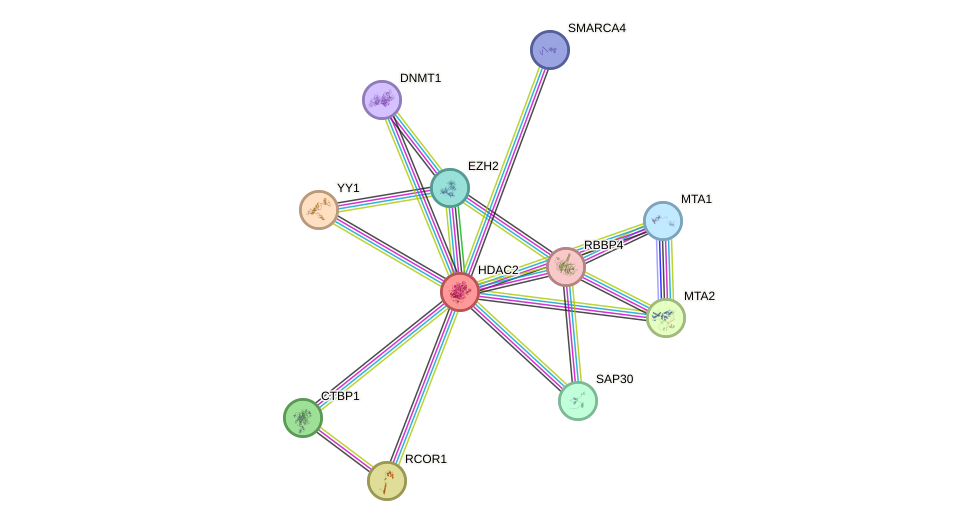GenAge entry for HDAC2 (Homo sapiens)
Gene name (HAGRID: 207)
- HGNC symbol
- HDAC2
- Aliases
- RPD3; YAF1
- Common name
- histone deacetylase 2
Potential relevance to the human ageing process
- Main reason for selection
- Entry selected based on evidence linking the gene product to the regulation or control of genes previously linked to ageing
- Description
HDAC2 performs the deacetylation of histones and is an important player in may processes such as development, transcriptional regulation, and cell cycle progression [736]. Homologues of HDAC2 have been linked to longevity in yeast [203] and to ageing and caloric restriction in fruit flies [202]. Whether HDAC2 is involved in human ageing, however, is not known.
Cytogenetic information
- Cytogenetic band
- 6q21
- Location
- 113,936,156 bp to 113,971,195 bp
- Orientation
- Minus strand
Protein information
- Gene Ontology
-
Process: GO:0000122; negative regulation of transcription from RNA polymerase II promoter
GO:0001975; response to amphetamine
GO:0003300; cardiac muscle hypertrophy
GO:0006338; chromatin remodeling
GO:0006344; maintenance of chromatin silencing
GO:0006351; transcription, DNA-templated
GO:0007596; blood coagulation
GO:0008284; positive regulation of cell proliferation
GO:0009913; epidermal cell differentiation
GO:0010718; positive regulation of epithelial to mesenchymal transition
GO:0010870; positive regulation of receptor biosynthetic process
GO:0010977; negative regulation of neuron projection development
GO:0016358; dendrite development
GO:0016575; histone deacetylation
GO:0031000; response to caffeine
GO:0032496; response to lipopolysaccharide
GO:0032732; positive regulation of interleukin-1 production
GO:0032760; positive regulation of tumor necrosis factor production
GO:0032922; circadian regulation of gene expression
GO:0032967; positive regulation of collagen biosynthetic process
GO:0034605; cellular response to heat
GO:0035094; response to nicotine
GO:0042220; response to cocaine
GO:0042475; odontogenesis of dentin-containing tooth
GO:0042493; response to drug
GO:0042517; positive regulation of tyrosine phosphorylation of Stat3 protein
GO:0042733; embryonic digit morphogenesis
GO:0043044; ATP-dependent chromatin remodeling
GO:0043066; negative regulation of apoptotic process
GO:0043392; negative regulation of DNA binding
GO:0043433; negative regulation of sequence-specific DNA binding transcription factor activity
GO:0045347; negative regulation of MHC class II biosynthetic process
GO:0045862; positive regulation of proteolysis
GO:0045892; negative regulation of transcription, DNA-templated
GO:0045893; positive regulation of transcription, DNA-templated
GO:0045944; positive regulation of transcription from RNA polymerase II promoter
GO:0048149; behavioral response to ethanol
GO:0048714; positive regulation of oligodendrocyte differentiation
GO:0055093; response to hyperoxia
GO:0060789; hair follicle placode formation
GO:0061000; negative regulation of dendritic spine development
GO:0061029; eyelid development in camera-type eye
GO:0061198; fungiform papilla formation
GO:0070301; cellular response to hydrogen peroxide
GO:0070932; histone H3 deacetylation
GO:0070933; histone H4 deacetylation
GO:0071300; cellular response to retinoic acid
GO:0071560; cellular response to transforming growth factor beta stimulus
GO:1901796; regulation of signal transduction by p53 class mediator
GO:1903351; cellular response to dopamine
GO:2000757; negative regulation of peptidyl-lysine acetylation
Cellular component: GO:0000790; nuclear chromatin
GO:0005634; nucleus
GO:0005654; nucleoplasm
GO:0005737; cytoplasm
GO:0016580; Sin3 complex
GO:0016581; NuRD complex
GO:0035098; ESC/E(Z) complex
GO:0043234; protein complex
Hide GO termsFunction: GO:0000978; RNA polymerase II core promoter proximal region sequence-specific DNA binding
GO:0000980; RNA polymerase II distal enhancer sequence-specific DNA binding
GO:0001047; core promoter binding
GO:0001103; RNA polymerase II repressing transcription factor binding
GO:0003682; chromatin binding
GO:0004407; histone deacetylase activity
GO:0005515; protein binding
GO:0008134; transcription factor binding
GO:0019213; deacetylase activity
GO:0019899; enzyme binding
GO:0031072; heat shock protein binding
GO:0031492; nucleosomal DNA binding
GO:0032041; NAD-dependent histone deacetylase activity (H3-K14 specific)
GO:0033558; protein deacetylase activity
GO:0043565; sequence-specific DNA binding
GO:0044822; poly(A) RNA binding
GO:0051059; NF-kappaB binding
Protein interactions and network
- Protein-protein interacting partners in GenAge
- TP53, STAT3, IRS1, MYC, TCF3, PARP1, BRCA1, CREBBP, HIF1A, NR3C1, TOP2A, TOP2B, NFKB1, CEBPA, PML, HELLS, RB1, HSF1, RELA, SIRT1, HDAC1, SP1, CCNA2, CREB1, APEX1, SIN3A, HDAC2, MXD1, ESR1, NFKBIA, ATR, SIRT6, BUB3, SIRT7, NCOR2, TP73, NFE2L2, CDKN1A, CDK7
- STRING interaction network
Retrieve sequences for HDAC2
Homologs in model organisms
In other databases
- CellAge
- This gene is present as HDAC2

